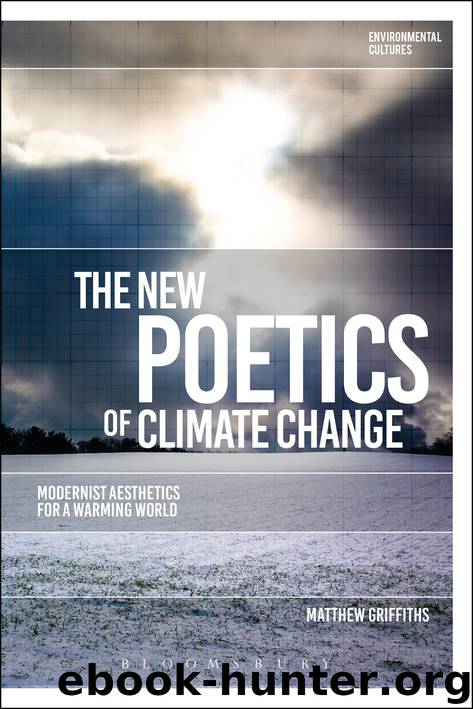The New Poetics of Climate Change by Matthew Griffiths

Author:Matthew Griffiths
Language: eng
Format: epub
Tags: Modernist Aesthetics for a Warming World
Publisher: Bloomsbury UK
Published: 2017-03-12T16:00:00+00:00
Bunting unbound
Bunting enables even the ‘Furthest, fairest’ actors to participate in human experience while they remain ‘free of our humbug’, demonstrating the openness of his vision to phenomenal forces. The cosmic is the sublime – yet not truly the Wordsworthian sublime, because the key expression of the Romantic poet’s relation with nature involves a distinction from it. Early in The Prelude, Wordsworth creates a boundary between himself and his environment even at the moment he seems most responsive to it: ‘For I, methought, while the sweet breath of heaven / Was blowing on my body, felt within / A correspondent breeze, that gently moved / With quickening virtue’ (1979 [1850]: 31; part I, lines 33–6). Wordsworth’s imagination is here enlivened in a manner akin to electromagnetic induction rather than by a literal inspiration of the breeze through nose or mouth, meaning that the meteorological and metaphorical breezes are, unexpectedly, separated at the skin. For Patricia Waugh, the passage marks a recognition that the form of the aesthetic is found in the world: ‘In Wordsworth’s writing, … we can detect that form situated in nature, a blessing in the gentle breeze which actually blows upon us to meet a corresponding breeze within’ (1992: 22), with the wind inspiring the shape of its imaginative reception. However, this correspondence between the breezes is not a transaction across boundaries as such: the human in the environment is still separate from it. In Bunting’s work, a dispersal of selfhood and what it means to be human addresses our implication in the environment in a way Wordsworth’s internalized process do not; as Mellors points out, a Late Modernist poet instead ‘learn[s] to express himself through it, to permit himself to be expressed by it’ (2005: 23).
Bunting modifies the Romantic discovery of the self in nature to create a sense of permeable, contingent identity, conditioned by and conditioning its environment. The elemental patterning of water in Briggflatts resists reduction to a single significance and erases human traces, though its permeation of selfhood is a motif Bunting has developed from his earliest work onwards. The third ode of Bunting’s First Book of Odes for instance opens with a first-person expression of passionate intensity, ‘I am agog for foam’, but quickly loses this ‘I’ in a profusion of plural pronouns ‘our loneliness … our envy’, ‘Its indifference / haunts us’ and so on (2016 [1926]: 79, lines 1, 11–14). Individuality here is expanded into a shared identity, and any character this has is contingent on the elements. Bunting opens ‘the possibility of relinquishing boundaries’ (Dempster 2007: 97), both between individual humans, and between culture and nature. Compare this with the opening of The Prelude: Wordsworth’s ‘blessing in this gentle breeze’ (1979 [1850]: 29; part I, line 1) is instrumental in the creation of the self with the sympathetic ‘corresponding’ mild creative breeze it engenders. In Bunting, while the environment conditions human experience, that experience is not individuated. Neither is nature benign in the ode; it is indifferent, not even comprehensible.
Download
This site does not store any files on its server. We only index and link to content provided by other sites. Please contact the content providers to delete copyright contents if any and email us, we'll remove relevant links or contents immediately.
4 3 2 1: A Novel by Paul Auster(12332)
The handmaid's tale by Margaret Atwood(7711)
Giovanni's Room by James Baldwin(7255)
Asking the Right Questions: A Guide to Critical Thinking by M. Neil Browne & Stuart M. Keeley(5709)
Big Magic: Creative Living Beyond Fear by Elizabeth Gilbert(5681)
Ego Is the Enemy by Ryan Holiday(5350)
The Body: A Guide for Occupants by Bill Bryson(5031)
On Writing A Memoir of the Craft by Stephen King(4893)
Ken Follett - World without end by Ken Follett(4685)
Adulting by Kelly Williams Brown(4536)
Bluets by Maggie Nelson(4515)
Eat That Frog! by Brian Tracy(4484)
Guilty Pleasures by Laurell K Hamilton(4395)
The Poetry of Pablo Neruda by Pablo Neruda(4066)
Alive: The Story of the Andes Survivors by Piers Paul Read(3998)
White Noise - A Novel by Don DeLillo(3982)
Fingerprints of the Gods by Graham Hancock(3966)
The Book of Joy by Dalai Lama(3946)
The Bookshop by Penelope Fitzgerald(3812)
